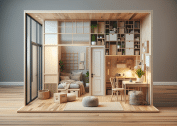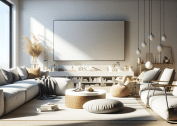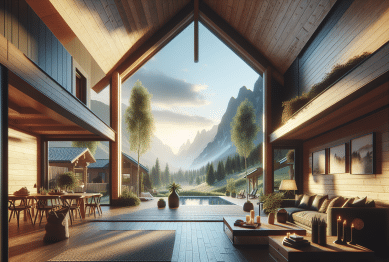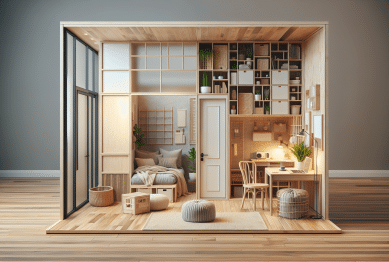Looking for inspiration that blends design and comfort? Discover how you can transform your living space with small changes that create big impact. This guide showcases practical, budget-friendly approaches to home décor and smart lifestyle adjustments for a more vibrant and inviting environment.
Understanding the Power of Interior Design Psychology
Interior design isn’t only about choosing colors or arranging furniture. It goes deeper, affecting mood, productivity, and even well-being. Color tones, natural lighting, and spatial arrangement can subconsciously influence feelings of relaxation or stimulation. For instance, soft blues and greens often invite calmness, while pops of yellow can spark creativity. Recognizing these subtle psychological triggers is a significant first step for anyone looking to upgrade their living environment for greater comfort and happiness. Even a fresh coat of paint or a reorganization can dramatically shift the atmosphere in your home. (See more about color psychology at the American Psychological Association: https://www.apa.org/monitor/2011/07-08/colors)
The psychology behind your home layout highlights why certain rooms feel warm and inviting while others feel less usable. Open layouts can encourage more social interaction, while small nooks can serve as cozy retreats. Reassessing these aspects allows more conscious control over how your space supports your daily lifestyle choices. Replacing a cluttered area with open shelving or multi-use furniture increases both utility and the visual spaciousness of the room. Using mirrors strategically can also brighten interiors, offering both style and function. By considering how every detail impacts the mind, each change thoughtfully supports health and happiness.
Scientific studies confirm that our surroundings deeply affect mood and behavior, impacting everything from sleep to stress levels. Personalizing décor, such as adding beloved art or family photos, enhances emotional safety and belonging. Small, data-backed interior shifts—like incorporating greenery for improved air quality—can also reduce anxiety and help concentration. The ultimate aim is to create a personalized environment that boosts both comfort and positivity, whatever the square footage. Learning about the psychology behind interior design is a valuable step before making any dramatic changes at home. (Read more at the National Institutes of Health: https://www.ncbi.nlm.nih.gov/pmc/articles/PMC7753767/)
Declutter for Wellness and Style
Simplifying your living space often brings a renewed sense of energy and focus. Clutter is more than just a visual nuisance—it can trigger stress and sap motivation. By curating what’s visible and organizing stored items with functional baskets or shelves, you free your space from distractions. Experts suggest the practice of mindful decluttering, removing items that no longer serve a purpose while making room for styles and objects that truly inspire. This approach leads to a cleaner, more peaceful home that supports daily well-being. (Learn about clutter and stress at Mayo Clinic: https://www.mayoclinic.org/healthy-lifestyle/adult-health/expert-answers/clutter-and-stress/faq-20477985)
Decluttering doesn’t require giving up personal treasures or stripping a home of character. It’s about intentional selection—keeping items that serve a real role, whether functional, sentimental, or beautiful. Storage solutions like under-bed bins, hanging organizers, and furniture that doubles as storage offer practical help without the need for major renovations. When surfaces are clear, remaining accent pieces like lamps or artwork become highlighted, creating a stylish, purposeful appearance. Reducing physical clutter often reflects in clearer, less anxious thought processes, helping you relax and enjoy time at home.
Building in small habits keeps clutter from creeping back. Quick daily tidying, sorting mail as it comes in, or using simple checklists supports ongoing order and serenity. Professional organizers recommend starting with easy-to-address spaces, such as kitchen counters or work desks, before moving to larger projects. Celebrate progress—every step adds up to a tidy, inviting home. Routines and organization are key lifestyle factors in reducing stress, supporting both physical and emotional health over time.
Embrace Natural Light and Greenery
Natural light ranks among the most effective ways to open up interiors and boost mood. Maximizing sunshine with sheer curtains or trimmed foliage allows light to flow while offering privacy. Research suggests that increased exposure to sunlight elevates serotonin levels, which in turn uplifts mood. If architecture limits sunlight, mirrors can be strategically positioned to reflect available light deeper into your rooms. Interior plant styling also plays a vital role, benefiting both aesthetics and air quality. Houseplants such as snake plants or pothos thrive in low light, while larger potted greenery can act as lively focal points in brighter areas of your home.
Plants not only contribute to visual freshness but help filter indoor air pollutants, creating healthier, more breathable spaces. The positive impact of indoor plants extends to enhanced productivity, reduced stress, and noise buffering, according to several academic studies. Whether selecting low-maintenance varieties or starting with simple succulents, the incorporation of greenery is widely celebrated for its beneficial effects on living environments. You don’t need to be an expert gardener; many resources provide guidance for beginners. (Explore plant health resources at RHS: https://www.rhs.org.uk/advice/profile?PID=872)
Adaptation is key for those with limited sunlight or outdoor access. Artificial lights designed for indoor plants help maintain green life year-round. Even in small apartments, hanging planters or wall-mounted shelves enable you to maximize vertical growing space for both culinary herbs and decorative foliage. Integrating natural textures, like wood and stone, further enhances a sense of the outdoors. These elements combined foster a healthy space where creativity and comfort flourish together, making every day feel a little brighter.
Affordable Ideas to Redefine Comfort and Style
Improving home style and comfort doesn’t require costly renovations. Simple swaps—like changing throw pillow covers or area rugs—create new color palettes with immediate impact. Rearranging existing furniture can make rooms feel larger or more functional without buying anything new. Artwork, whether framed prints or personal photographs, brings personality and provides affordable yet striking visual interest. Consider rotating accessories throughout the year for a fresh look each season. Drastic improvement can happen with thoughtful, budget-friendly changes that honor your taste and needs.
Textiles add both comfort and a designer touch. Soft blankets, tactile throws, and layered curtains can be changed according to the season or mood. Inexpensive lighting, such as fairy lights or floor lamps, cast a gentle glow and elevate evening ambiance. Many designers recommend incorporating at least one element of surprise, like an unconventional lamp or bold wall accent, which sparks curiosity and conversation. These creative, attainable shifts are within anyone’s reach and enhance feelings of coziness, warmth, and home pride.
For those keen to express a curated lifestyle, DIY projects offer high satisfaction without major investment. Repurposing furniture with paint or new hardware, upcycling decorative objects, or making custom wall art allows for personalization at a fraction of store-bought prices. This approach also encourages sustainability by reducing waste. Countless online tutorials from reputable institutions provide guidance for all skill levels. The process itself fosters joy, resourcefulness, and a meaningful sense of accomplishment.
Keeping Trends Balanced with Personal Expression
Trends drive innovation and offer new perspectives, but lasting comfort is rooted in personal expression. Following every trend can create a home that feels impersonal or transient. Instead, select trend elements that resonate with existing style, integrating bold patterns or statement pieces thoughtfully rather than all at once. Curated approaches allow spaces to evolve while reflecting personality and heritage, blending fashionable items with timeless favorites.
Experts suggest exploring trend guides from respected design organizations to identify which elements resonate with your own sense of style. Minimalist trends promote calm by reducing unnecessary accents, while biophilic design combines nature-inspired patterns for comfort. Balancing current influences with what feels authentically you is at the heart of sustainable style. Experimentation is encouraged—spaces should change in response to evolving tastes and life circumstances. Check design trend insights at the American Society of Interior Designers: https://www.asid.org/resources/research
Personal touches tell stories. Handcrafted items, heirloom décor, or souvenirs from travels all add unique charm that trends alone can’t achieve. Combining the occasional trendy piece with family photos, custom crafts, or beloved books ensures the space feels lived-in, not staged. This blend results in an environment supportive of both relaxation and inspiration. As a result, your home reflects both current influences and enduring individuality, adapting effortlessly as your journey continues.
Daily Habits for Lasting Positive Vibes
Lifestyle goes beyond aesthetics. Daily rituals enhance the energy of any room and keep living spaces feeling renewed. Letting in fresh air, opening blinds in the morning, or diffusing calming scents helps set a positive tone. Establishing routines like making the bed, refreshing sofa cushions, or playing ambient music creates structure and harmony. These actions are proven to lift spirits and contribute to better overall mental health, regardless of the size or design of a space.
Maintaining comfort and cleanliness is an ongoing, mindful practice. Scheduling regular deep cleans or small maintenance tasks prevents common issues like dust, odors, or seasonal disorganization. Using eco-friendly cleaning products, airing out rugs, and washing curtains promote a healthier home. These routines provide a sense of accomplishment and calm, reducing overwhelm and preventing clutter reaccumulation. They also encourage housemates or family members to share responsibility for the shared environment.
Finally, conscious consumption and gratitude enhance lasting contentment. Regularly taking stock of your surroundings, noticing small details you appreciate, boosts well-being. Expressing thanks for a favorite reading corner or cozy blanket reframes ordinary settings as sources of comfort. This mindset supports a sustainable approach to lifestyle changes, focusing not just on visual results, but on deeper satisfaction and personal growth over time.
References
1. American Psychological Association. (2011). The Power of Color. Retrieved from https://www.apa.org/monitor/2011/07-08/colors
2. National Institutes of Health. (2020). The Influence of Interior Environments on Stress and Health. Retrieved from https://www.ncbi.nlm.nih.gov/pmc/articles/PMC7753767/
3. Mayo Clinic. (n.d.). Clutter and Stress: What’s the Connection? Retrieved from https://www.mayoclinic.org/healthy-lifestyle/adult-health/expert-answers/clutter-and-stress/faq-20477985
4. Royal Horticultural Society. (n.d.). Houseplant Advice. Retrieved from https://www.rhs.org.uk/advice/profile?PID=872
5. American Society of Interior Designers. (n.d.). Industry Research and Trends. Retrieved from https://www.asid.org/resources/research
6. Harvard Health Publishing. (2023). How Light Affects the Mind and Body. Retrieved from https://www.health.harvard.edu/mind-and-mood/light-and-your-health









